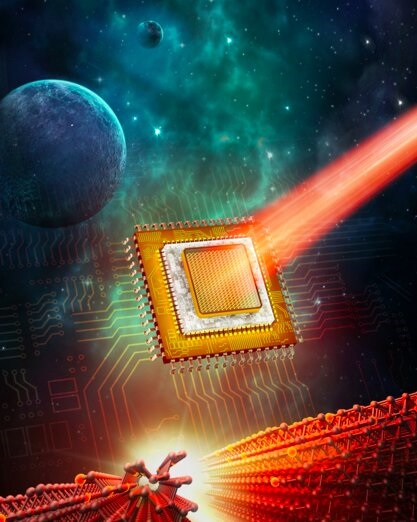High dark current can significantly impair the performance of infrared photodetectors, devices that can detect photons in the form of infrared radiation. For many years, most solutions for blocking dark current used the electric field inside the detectors.
Researchers at the Chinese Academy of Sciences recently devised an alternative solution to suppress dark current in photodetectors, which is based on the use of van der Waals (vdW) heterostructures. They presented visible and mid-wavelength infrared unipolar barrier photodetectors made of band-engineered vdW heterostructures.
“Since Bell Labs produced the Si-based PN junction in 1935, using the built-in electric field in the depletion region has become the main technical route to block dark current. In traditional PN junctional infrared photodetectors, the high Shockley-read-Hall (SRH) recombination and surface recombination in the depletion region seriously limit the suppression of dark current. In response to these issues, engineers introduced a new device structure beyond the PN junction, namely the unipolar barrier structure.
The key idea behind vdW unipolar barrier heterostructures can be used to suppress dark current inside photodetectors. By blocking majority carriers, in fact, these structures could ultimately allow infrared photodetectors to operate at high temperatures, achieving remarkable performances.
“The proposed novel vdW unipolar barrier heterostructures could be a solution to the bottleneck of dark current in infrared photodetectors and further improve the performance of infrared photodetectors,” Researchers said. “Eventually, they could thus facilitate the ‘lab-to-fab’ transition of two-dimensional (2D) materials in infrared applications.”
Recently, more researchers have started designing and using photodetectors with unipolar barrier structures (typically nBn and pBp heterostructures) to suppress dark current and enable operation at high temperatures. These barrier layers can block dark current, yet they allow photocurrent to flow freely.
“In the case of nBn, the conduction band barrier can effectively block the movement of electrons from the contact layer to the absorption layer and make the surface current greatly attenuated,” Researchers explained. “At the same time, the distribution of the depletion region is close to the wide-bandgap barrier layer, which reduces the SRH current. In addition, with the decrease of the carrier concentration in the absorption layer, the Auger recombination which determines the hot noise can be effectively suppressed.”
When designing the barrier layer inside photodetectors, engineers should take characteristics such as band alignment and lattice matching into consideration. Photodetectors with a vdW unipolar barrier could thus be made of two-dimensional (2D) materials, which avoid lattice-mismatch and interface defects associated with naturally self-passivated surfaces. Conveniently, 2D materials also have layer-tunable band structures, which can be scientifically designed and stacked to create nBn or pBp band alignments.
“The unipolar barriers can effectively suppress the dark current by introducing a large bandgap barrier layer,” Researchers said. “Thus, unipolar barrier photodetectors could operate at a higher temperature than a pn junction with the same dark current or have higher performance at the same temperature.”
Researchers and their colleagues were the first to realize wdW unipolar barrier photodetectors based on 2D layered materials. In addition, they conducted a systematic analysis of the components of dark current in unipolar barrier structures.
In the future, the photodetectors created by this team of researchers could be used to enhance several sensing and imaging devices. Moreover, their work could inspire other teams to create similar photodetectors using 2D layered materials.
“The proposed novel vdW unipolar barrier heterostructures make a key technological breakthrough to the ‘lab-to-fab’ transition of two-dimensional materials in the field of infrared applications such as remote sensing and infrared imaging,” Researchers said. “Based on previous research, novel structure optimization, scalable infrared focal plane array (FPA) and functional applications such as dual-band detection and polarization infrared imaging are our following targets.”








